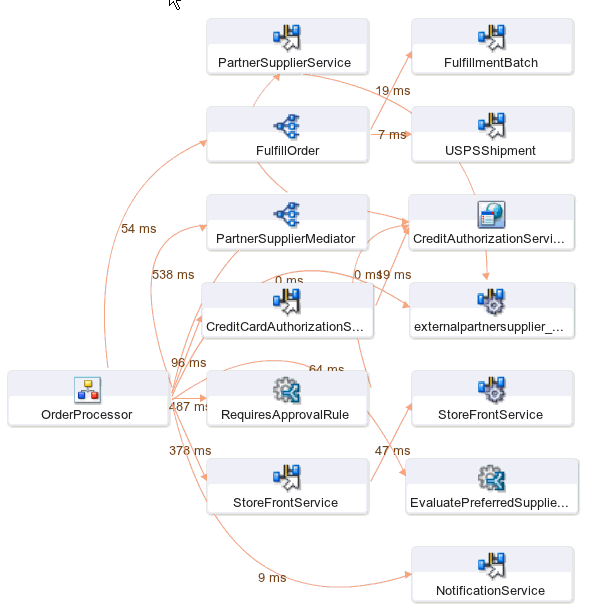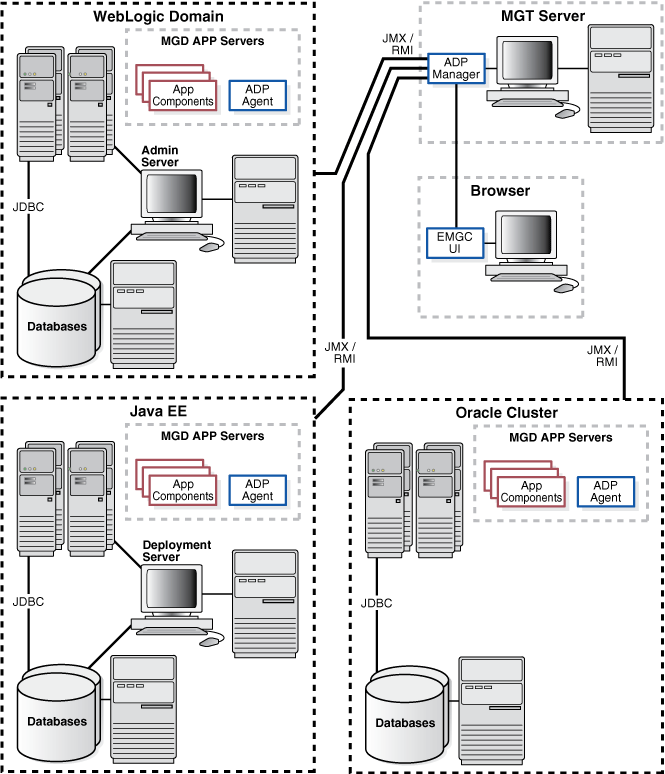38 Introduction to Application Dependency and Performance
The Application Dependency and Performance (ADP) pages within Enterprise Manager Cloud Control analyze ADF and SOA Suite applications to capture the complex relationships among various application building blocks in its Application Schema model - the core of the Oracle intelligent platform.
Using ADP you can:
-
Monitor performance of applications deployed in the following type of Servers:
-
Oracle SOA Suite 11g
-
Oracle Application Development Framework (ADF)
-
-
Have visibility into components defined by way of metadata within a framework (for example, components within a composite) with deep dive visibility, where available
-
View static relationships defined within SOA Composites, such as between SOA Services, references, and components
This chapter includes the following:
38.1 Overview
Using application framework metadata, ADP is able to deliver monitoring that is automatically configured out of the box and evolves with change. ADP enables an enterprise to more efficiently manage distributed applications, attain management agility, and lower total cost of ownership.
See the following sections:
38.1.1 Managing Complex SOA Suite and ADF Applications
Today's SOA Suite and ADF applications enable enterprises to deliver mission-critical business functions to key constituencies - most often their customers, partners, and employees. These composite applications are assembled from many different Java EE components and exposed services distributed across a heterogeneous environment.
To be effective at managing today's complex, distributed SOA Suite and ADF applications across a heterogeneous environment, enterprises must adopt an intelligent monitoring platform with the following characteristics:
-
Provides holistic, service-oriented views across heterogeneous environments
An intelligent monitoring platform must provide high-level service-oriented metrics that map to low-level technology-centric metrics. These measurements must be organized in a service-oriented fashion to deliver a unified, holistic view of the numerous interconnected application components deployed across heterogeneous environments.
-
Requires minimal SOA Suite and ADF application expertise
An intelligent monitoring platform must have the ability to capture complex relationships among various interconnected components of today's SOA Suite and ADF applications. This ability can help minimize reliance on SOA Suite and ADF application experts for setting up and maintaining effective APM environments.
-
Eliminates repetitive DIY manual processes
An intelligent monitoring platform must eliminate repetitive DIY manual processes by delivering the ability to self-customize out-of-the-box and evolve with change. Elimination of these repetitive DIY manual processes is the only way to deal with rising complexity and rapid rate of change with ease.
38.1.2 Delivering a Service-Oriented View Across Environments
Today's mission-critical business functions are powered by SOA Suite and ADF applications that comprise numerous interconnected components deployed across highly distributed environments. To manage these applications effectively, enterprises must first gain an understanding of the complex relationships among the business functions, associated interconnected components, and the underlying runtime environments. To enable clear and accurate understanding, IT organizations need holistic, service-oriented views that span across heterogeneous environments.
Furthermore, appropriate rendering of these views enables users at different levels of the organization to collaborate with each other and do their respective jobs more efficiently.
Figure 38-1 Application Dependency and Performance Topology View in Enterprise Manager Cloud Control

Description of "Figure 38-1 Application Dependency and Performance Topology View in Enterprise Manager Cloud Control"
Application Schema Navigation provides efficient ways for you to access relevant information using techniques like hierarchical traversal, architecture model navigation, string queries, drill down, drill out and more.
38.1.3 Eliminating Repetitive Do-It-Yourself (DIY) Manual Processes
Based on a unique model-driven approach, ADP eliminates repetitive DIY manual processes. To achieve this level of self-customization and continuous change adoption, ADP uses its AppsSchema modeling technology to perform the critical task of analyzing application structure and infrastructure configuration. After capturing these insights in the Application Schema model, ADP leverages this information to establish a fully customized monitoring environment. To keep this environment up-to-date, ADP continuously updates the Application Schema model as new applications are deployed and changes are applied. ADP's unique ability to self-customize out-of-the-box and evolve with change enables fast time-to-value, low total-cost-of-ownership (TCO), and maximal return-on-investment (ROI).
38.1.4 ADP Solution
Oracle provides an intelligent monitoring platform for SOA Suite and ADF. Unlike conventional performance management tools, ADP analyzes the metadata of these frameworks and captures the relationships with the various application components.
38.2 Architecture
ADP employs a multi-tier, fully distributed, configurable architecture to provide the scalability and flexibility to meet the changing needs of enterprise deployments.
ADP operates as a service on the machine and automatically begins running when the machine first boots, and remains on perpetually. ADP is typically installed on its own machine and dedicated to monitor a group of managed application servers.
The following core components are deployed to form the ADP monitoring system.
38.2.1 ADP Java Agents
ADP Java Agents are the data collectors of the ADP monitoring system. ADP Java Agents are deployed to all managed application servers to perform a series of tasks including collecting performance managements, tracking contextual relationships, and summarizing data in real-time while introducing as little overhead as possible. At the expiration of the predefined aggregation interval, these agents forward the summarized data to ADP for additional analysis. For various Java EE platforms such as Oracle SOA Suite and Oracle WebLogic, ADP leverages their deployment infrastructures to quickly deploy the ADP Java Agents to all application servers.
38.2.2 ADP Manager
ADP Manager is the core analytical engine of the ADP monitoring system. In real-time, ADP Manager performs complex mathematical modeling and statistical calculations with summarized data from all ADP Java Agents. ADP Manager can be configured with a backup to provide higher level of availability.
38.2.2.1 ADP Manager and High Availability
Although the ADP Manager does not have high availability (HA) built into it, administrators can have a backup ADP Manager installed on a separate machine; this backup ADP Manager points to the same database but is disabled. If the production ADP Manager fails, the backup ADP Manager can then be enabled against the same database. The backup ADP Manager then rediscovers the application after the agent is redeployed from the backup ADP Manager, to the managed resources in order to synchronize them. All metrics are preserved, assuming the model does not change in the short time frame it takes to bring the backup ADP Manager online.
The key with this backup procedure is to backup the database that ADP uses as its repository in order to preserve the historical data. On the modeling side, the backup ADP Manager has to rediscover the application which should happen automatically, as long as the resources are configured and the new agent has been deployed.
If historical data preservation is not a necessity, users can simply have another ADP Manager and database and swap agents reducing the backup effort considerably.
38.2.3 ADP User Interface
The ADP User Interface (ADP UI) is the primary user interface for ADP users. Users can use ADP UI to set Service Level Objectives (SLOs), analyze monitoring data, and more. The ADP UI is fully configurable. To access ADP:
-
From the Targets menu, select Middleware.
-
From the Middleware Features menu on the Middleware page, select Application Dependency and Performance.
